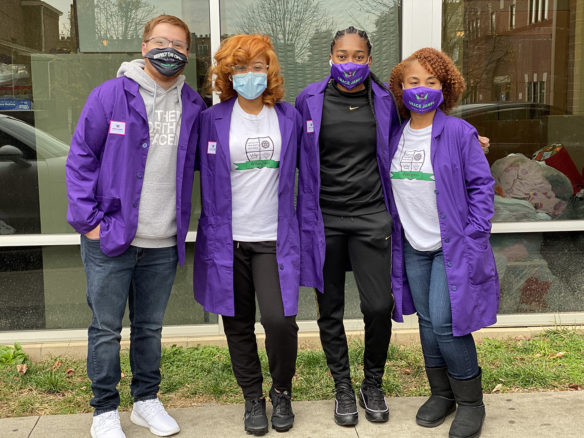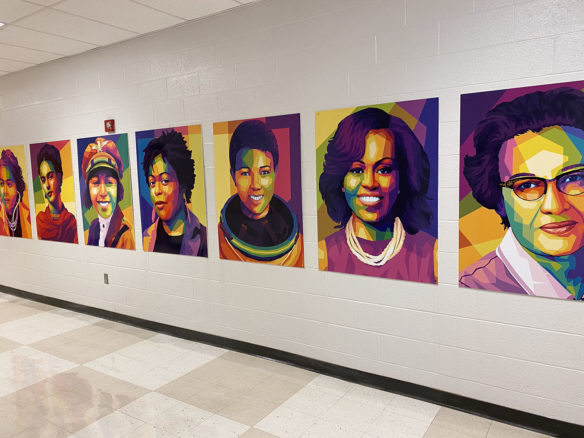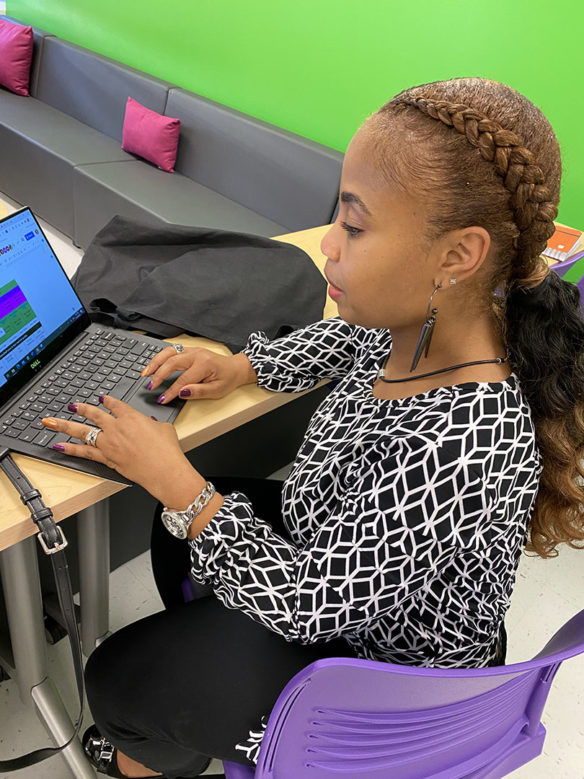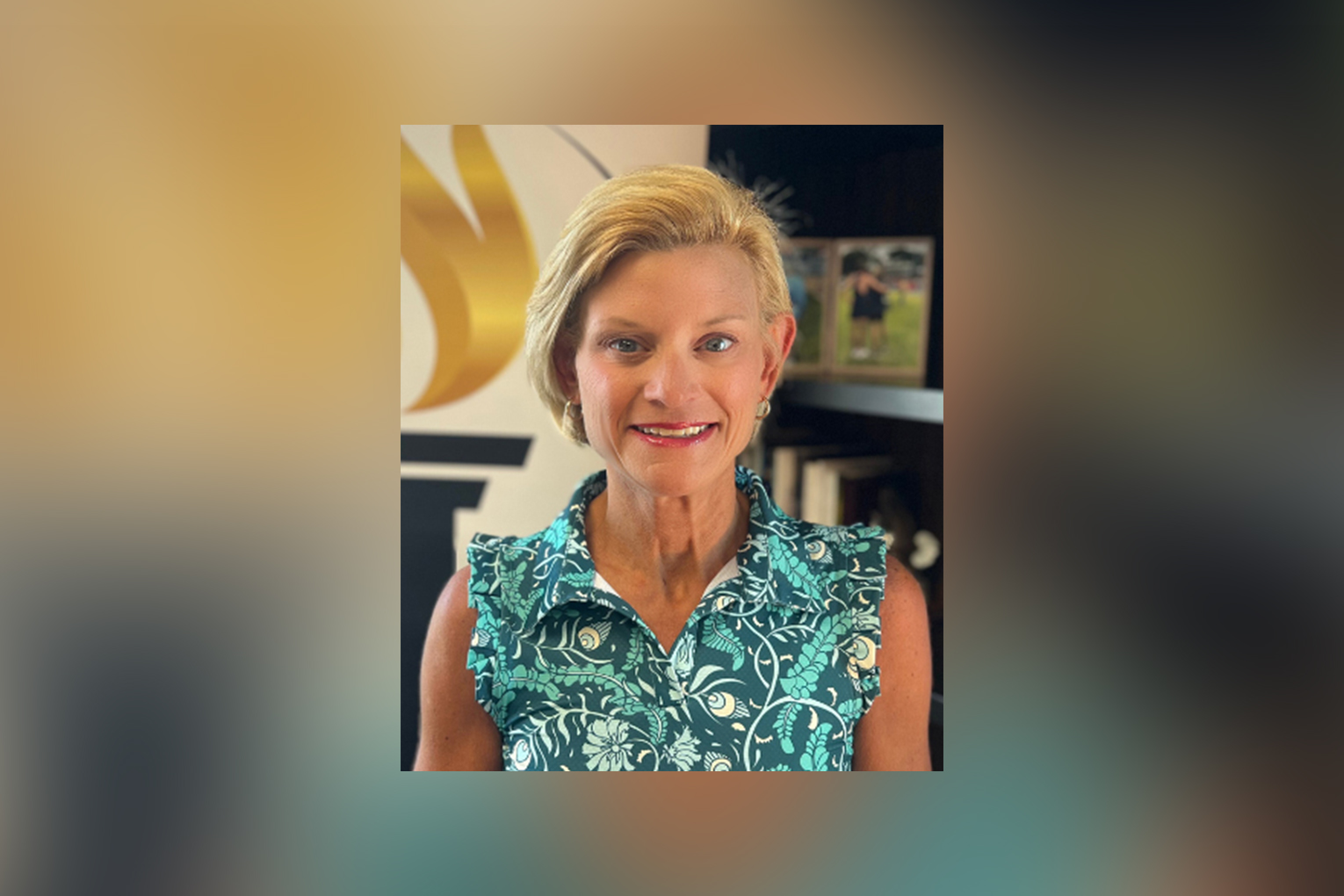
Grace M. James Academy of Excellence personnel stand outside the Wayside Christian Mission on Nov. 14, 2020. From left are math teacher Cory Rawlins, English language arts teacher Ashley Hancox, mental health practitioner TeAra Davey and Assistant Principal LaTonya Frazier-Goatley. Grace James is a new Afrocentric, single-gender science, technology, engineering, arts and math magnet school in Jefferson County,
Photo submitted
- The James Academy opened in fall 2020.
- Single-gender and minority-focused schools are a growing trend nationwide.
By Jim Gaines
jim.gaines@education.ky.gov
Until recently, the 149 students of the Grace M. James Academy for Excellence have only seen inside their middle school via a cell phone camera held by Principal Ronda Cosby and other staff members.
The 6th-graders are the first class to attend the new science, technology, engineering, arts and math (STEAM) magnet school in Jefferson County, but COVID-19 means most of their experience has been virtual during the 2020-2021 academic year. They moved to hybrid classes April 5, Cosby said.
When they began attending in person, they and the next class will be in a unique place: an Afrocentric, single-gender STEAM school that doesn’t even have traditional classroom desks.
Half the seating is soft chairs and beanbags, like a living room or coffee shop; the other half is high-top tables or booths, Cosby said. Students can choose where they want to sit each day. All the furniture is movable so it can be adjusted to class needs, she said. Even the front office has a variety of informal seating.
“Learning should be comfortable and not rigid,” Cosby said.
Many teachers at other schools still use the traditional setting of rows of hard desks, she said. But if they want students to be comfortable in their learning space, educators have to create an environment better suited for learning.
“I’m all about disrupting traditional schooling,” Cosby said. “We have to change for the kids that we serve, even if it makes us as adults uncomfortable.”
Family Feeling
Trinity Reed is one of the students finding her comfort zone at James Academy. She attended a primarily White school from kindergarten through 5th grade. Reed decided to apply to James Academy in part because it promised to be “very interactive,” but also because it offered a chance to learn about people of color like herself, she said.
“I thought I knew what was going to happen,” Reed said. “I thought ‘Oh, I’m ready for this.’”
She found James Academy very different from what she thought – “but in a good way.” It feels close-knit and non-hierarchical, with a comfortable and casual classroom environment, she said. That makes James Academy more like a family than a school, Reed said.
“The teachers are the teachers, but you can come to them if you need help,” she said. “If you notice something that’s a little off, it’s not off-limits to speak to the adults in that situation.”
At her previous school Reed struggled with math and didn’t show much confidence in class. But at James Academy she feels free to speak up, and that growth is showing in improved grades, she said.
Reed goes to class with students whose interests are similar to hers, which makes it easier to make friends, she said. She is heavily involved in after-school activities: president of the Black Student Union and a member of Girls Who Code. In those groups and in her “Sister Circle,” Reed can connect with other students who see the need for change, she said.

Pictures of inspiring women of color line a hallway at the Grace M. James Academy of Excellence. From left are school namesake Grace Marilyn James, social activist and pediatrician; Frida Kahlo, painter and activist; civil aviator Bessie Coleman; Kimberly Jones, founder of Black Girls Code; astronaut Mae Jemison; former First Lady Michelle Obama; and NASA mathematician Katherine Johnson.
Photo submitted
Student Organization
Traditional middle schools have an advisory period. The James Academy instead has formed “Sister Circles” of 10 girls and a teacher or staff member, in which they can talk about social and emotional matters, Assistant Principal LaTonya Frazier-Goatley said. The circles are part of five larger “GEM Communities,” each of which is based on one of the school’s CROWN values: Collaboration, Resilience, Originality, Willingness and Narrative.
The school meets monthly for “Crown Day,” in which all students gather to meet Black engineers, authors, meteorologists and other professional role models, Frazier-Goatley said.
As outlined in sociologist Abraham Maslow’s Hierarchy of Needs, if students don’t have their needs for safety, security, a sense of belonging and love met, they aren’t able to learn effectively, Cosby said.
Those basics have to be addressed every day. That’s the purpose of the Sister Circles, Cosby said. Participation in a stable group that remains unchanged in their time at the school gives students a sense of belonging and encourages them to build relationships, she said.
Middle school is a challenging time emotionally, psychologically and physically, and students often pay more attention to their peers than to adults, Cosby said.
“We encourage that, but in a positive way,” she said.
James Academy also doesn’t have a traditional parent-teacher association (PTA). Instead it has “Families of the Crown” – parent representatives from each Gem Community who work together which recognize that parents have different ways for supporting the school, Cosby said.
Genesis
The Jefferson County Board of Education authorized the creation of the James Academy in August 2019. It opened a year later, two years after the opening of Jefferson County’s all-male W.E.B. DuBois Academy. The James Academy is open to all rising 6th-grade female students in Jefferson County, but its inaugural class is predominantly Black and the school has a deliberate Afrocentric focus.
The school is named for Dr. Grace Marilynn James, the first Black female medical doctor to join the University of Louisville School of Medicine faculty and the first Black female member of the Jefferson County Medical Society. It shares space in the DuValle Education Center – a former junior high school – with three other programs, including Carter Elementary, Cosby said.
James Academy received more than 400 applications for its first year, Cosby said.
“Next year we’ll accept 150 more for our 6th-grade class coming in,” she said.
Leading a Trend
The James and DuBois academies exemplify a major national trend and can serve as models for other Kentucky schools, said Thomas Woods-Tucker, who in October 2020 became KDE’s first chief equity officer and deputy commissioner in the Office of Teaching and Learning.
“These single-gender academies, and academies that are drawing a certain majority ethnic population like African-American boys, have had an explosion,” he said.
Since 2014, 850 new single-gender academies have opened across the country, part of a 25-fold increase in the past decade, Tucker said.
Every Kentucky student is guaranteed a free appropriate public education, but students from particular ethnic or socioeconomic backgrounds have needs that have to be addressed, he said.
“We haven’t done the best jobs of meeting the needs of those students or meeting the needs of students with unique learning needs, students with IEPs or autism,” Tucker said.
He said that while the James Academy is open to all ethnicities, its Afrocentric curriculum ensures that young girls of color have the same opportunities to excel as students in more traditional settings.
It reminds Tucker of his own time at Philander Smith College, a historically Black college or university (HBCU) in Little Rock, Ark. He said the mission of HBCUs mirrors that of JCPS’s all-female STEAM academy, which is addressing the unmet needs of underserved students – whether that means members of a marginalized ethnic group, a specific gender or students from underprivileged backgrounds.
Whether single-gender or coeducational, such schools tend to have smaller class sizes and a lower student/teacher ratio.
Single-gender education provides a feeling of safety and allows for the development of mentoring, allowing students to take risks without ostracism, Woods-Tucker said. There is a strong emphasis on building relationships, which creates a sense of belonging.
“Students who thrive in these single-gender schools feel like they’re with ‘their people,’” he said. “What they’re really saying is, ‘I belong here, I am comfortable.’”
When Tucker was a superintendent in Ohio in 2014, he looked at the number of girls vs. boys taking AP classes in his district. In higher grades, fewer girls enrolled in advanced classes.
“One of the things they said over and over was … that they didn’t feel comfortable being risk-takers,” he said.
Using a technology grant, his district developed technology and AP classes for girls only.
“And what we saw over a three-year period was really phenomenal in terms of the number of girls enrolling in these classes,” Tucker said.

Assistant Principal LaTonya Frazier-Goatley leads a session during the Grace M. James Academy of Excellence’s first open house in September 2020.
Photo submitted
Getting In
The James Academy’s admission period for the following school year opens at the end of October and usually runs until the second week of December, Frazier-Goatley said.
Admission is by application, with a recommendation from a current teacher or community leader, and a “performance task” – a two-minute video on how the applicant fits the school’s values.
Students have to first apply with JCPS’s magnet school department, Frazier-Goatley said.
“We also look at their previous attendance,” Cosby said. Illnesses and deaths in the family don’t count against them, but otherwise student attendance needs to be consistent, she said.
Although COVID-19 has ruled out reliance on this year’s assessment scores, in general multiple assessment scores will be considered, Cosby said.
“Grades are very, very subjective, so we don’t put a lot of emphasis on that,” she said. Disciplinary records also are a factor, but those can be as biased as grades, Cosby said.
“One thing I did not want it to be was elitist and affluent,” she said. Cosby wants James Academy to be open to everyone whose goals are consistent with the school’s mission, providing students with what they can’t receive in their homes or previous school environments.
Getting Ready
Previously, Cosby was principal of Chancey Elementary and could have retired in July 2020. But she had always wanted to work in a space where she could create a strong sense of belonging, allow students’ cultural assets to enhance the classroom experience instead of being muted in the classroom, and integrate their cultural assets with everything done at James Academy, she said.
“When they decided to open this school, I saw an opportunity I could not pass up,” Cosby said. “This was an opportunity to give a voice to girls who look just like me.”
Cosby said people like herself and Frazier-Goatley usually were “visibly invisible in the classroom,” seeing nothing in the school library, teaching or curriculum representing themselves or their experiences.
She made sure to hire a “cultural humility coach” for James Academy who supports the purposeful infusion of an Afrocentric perspective in what they do. The coach is there to educate administrators and illuminate how many of their practices are things they’ve unconsciously adopted.
When starting a STEAM school with a declared Afrocentric, gender-centric focus, it’s vital to consciously implement those things, Cosby said.
“Just because you are a Black American doesn’t mean you know all the historical background of our particular culture, or understand the complicated levels of racism and how it can subtly appear in a classroom – and overtly appear in a classroom,” Cosby said.
Doing Things Differently
Cosby hired two assistant principals in February 2020, who helped her lay the foundation for what they wanted the school to become. Together they worked to hire the teachers.
As part of their interview, each teacher candidate had to present a digital portfolio on academic rigor and teaching STEAM subjects through an Afrocentric, gender-specific lens, Cosby said.
Then they had to do an on-demand performance task to demonstrate their strength in planning lessons from those perspectives.
“It is not for everyone, because we go against the grain on a lot of things about what people think school is and should be,” Cosby said.
Cory Rawlins is a new math teacher who was hired straight out of college. The Ohio native graduated from Morehead State University, and when looking for a job, he sought out schools with diverse populations. He found the intensive interview process at James Academy “shocking,” he said.
“I’ll be honest: I was like, ‘Man, I don’t know if I’m cut out for this,’” Rawlins said. But he likes challenges and knew immediately he wanted to be at James Academy.
This year, Rawlins said, his students have taught him about life skills and social justice issues he hadn’t encountered on his own.
Rawlins uses a problem-based approach in teaching instead of lecturing or handing out worksheets. He acts a facilitator while student voices control how the class tackles problems, he said. That’s a freedom most of his students haven’t had before, Rawlins said.
“We’re learning every single day how to make it better and better,” he said.
The framing of lessons relates to the students’ lives. Rawlins’ class recently studied ratios and percentages by reviewing COVID-19 case numbers, he said.
Always Changing
As the world changes, education has to evolve with it instead of projecting previous generations’ learning experiences onto the current generation of students, Cosby said. That’s sometimes uncomfortable.
Every week or two, the school seeks student feedback through a survey, Cosby said.
“We’ve made changes based on what students told us,” she said.
Administrators revamped the master schedule to give all class sections the same amount of time to complete assignments. They also changed the day and time that assignments were due based on student feedback.
Educators’ responsibility is not just to educate, but to care for the hearts and minds of others’ children and evolve as professionals, Cosby said. Until educators are aware of their own biases and how those impede real education, gaps in achievement will persist, she said.
Recognizing biases requires listening to students, and a willingness to incorporate other perspectives in the educational experience, Cosby said.
“Students have plenty to say and can tell you about yourself, because they sit back and observe, but they’re just not allowed to speak,” she said.




Leave A Comment